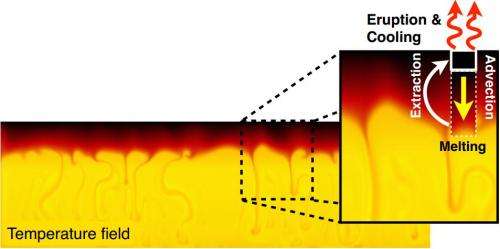September 26, 2013 report
Research duo suggest early Earth had heat-pipe channels similar to Jupiter's moon Io

(Phys.org) —Two planetary researches, one from Hampton University and the National Institute of Aerospace, the other from Louisiana State University, have published a paper in the journal Nature suggesting that for a period of time, the Earth was very similar to Jupiter's moon Io—with heat from within being released through what are known as heat-pipes. The new theory by William Moore and Alexander Webb goes against the common consensus that the Earth transitioned directly from a planet with a hot molten liquid layer to one covered by tectonic plates.
Planetary scientists have been stumped in trying to figure out how a planet with a molten hot liquid surface could transition directly to one with tectonic plates—the only way that could happen would be if the planet cooled almost instantly. But all available evidence indicates it didn't, so how did the tectonic plates come about? Moore and Webb suggest there was an intermediate stage—one where heat was allowed to escape from the interior of the planet through heat-pipes.
In practical terms, heat pipes are soft material "holes" in a planet's surface. Hot magma from below is pushed upwards through channels towards the surface where it flows out as lava allowing heat to escape into space. While very similar to volcanoes, they don't necessarily erupt, they simply ooze. Jupiter's moon Io is an excellent example of a body that oozes lava, with so many heat-pipes that its entire surface is covered by material constantly pushed up from below. The result is a constant turnover of surface material, mixing with that from below. Moore and Webb theorize that a very similar situation existed on Earth between the time the surface was hot molten liquid and the development of tectonic plates. They suggest the constant movement of material up though the heat-pipes led to a build-up on the surface. As the planet cooled over time, the material that was pushed up slowly hardened and became the tectonic plates. And because there was still a lot of heat in the core of the planet, fissures developed which caused the plates to break apart and to travel as they continue to do today.
Moore and Webb point to ancient zircon and diamonds found on Earth to strengthen their theory—the rocks have been dated to the time period in question (roughly 3 to 4 billion years ago) and show the weathering that would have occurred had they been constantly churned by heat-pipe transport.
More information: Heat-pipe Earth, Nature 501, 501–505 (26 September 2013) DOI: 10.1038/nature12473
Abstract
The heat transport and lithospheric dynamics of early Earth are currently explained by plate tectonic and vertical tectonic models, but these do not offer a global synthesis consistent with the geologic record. Here we use numerical simulations and comparison with the geologic record to explore a heat-pipe model in which volcanism dominates surface heat transport. These simulations indicate that a cold and thick lithosphere developed as a result of frequent volcanic eruptions that advected surface materials downwards. Declining heat sources over time led to an abrupt transition to plate tectonics. Consistent with model predictions, the geologic record shows rapid volcanic resurfacing, contractional deformation, a low geothermal gradient across the bulk of the lithosphere and a rapid decrease in heat-pipe volcanism after initiation of plate tectonics. The heat-pipe Earth model therefore offers a coherent geodynamic framework in which to explore the evolution of our planet before the onset of plate tectonics.
Journal information: Nature
© 2013 Phys.org


















